Rigid Hull Inflatable Boats (RIBs) have many advantages. They don’t mark a boat’s hull when alongside, they have sufficient buoyancy to stay afloat when completely full of water, and they are sold in large enough quantities that pricing is competitive. They have lots of downsides as well and the demise of most inflatables is slow deflation that rarely poses a safety risk but can positively drive owners crazy. It can be challenging to chase down the source of a slow leak but pumping the boat up every second day is annoying as well. Many of these boats just get replaced. It turns out they really aren’t all that difficult to repair—the real challenge is finding the source of the leak. This one was easy to find.
Two weeks ago, we were underway at speed in moderate seas and the boat was fully inflated when it suddenly tilted to the right. I look down and the entire right side tube had just gone flat. Even more unusual, the tube quickly was vacuuming down to the shape of the fiberglass boat in which the tube was glued. It was exactly what you would see if you put a vacuum on the tube and removed all the air. I’ve never seen anything like it.
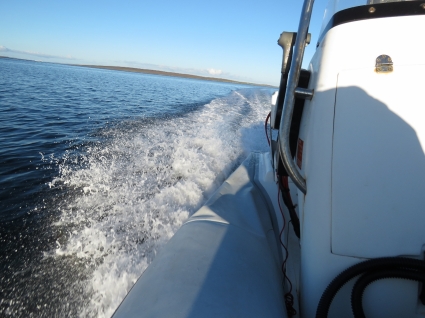
|
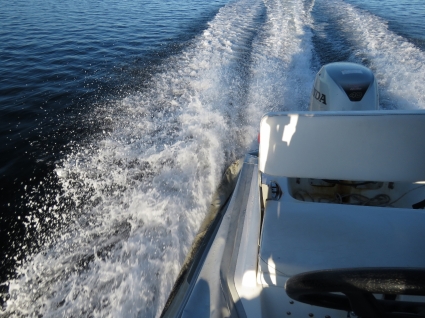
|
I asked Jennifer to go the opposite corner as I slowed down to investigate. As I slowed, the boat tilted toward the deflated tube since there was now no buoyancy in that side of the boat. The good news is that medium-sized ribs and above have three flotation chambers and are assured to stay floating if one chamber is out of commission. As we slowed, I realized two things: 1) the boat would float fine in flat water on two chambers, but in rough water it would certainly be swamped and 2) on plane was the safest operating mode for the boat under these conditions.
I shifted over to the far left side of the tender, with Jennifer as far forward and left as was safe, and brought the tender back to full speed doing a slow 180 degree turn back to Dirona. It was looking like we would make it. In fact, the boat leaned quite a bit right, but otherwise seemed to be doing fine. However, It was clear that if we were in heavy seas the boat would not be safe with only two flotation chambers full. It’s disappointing to see one of the key reasons I really like RIBs turn out to not really be correct.
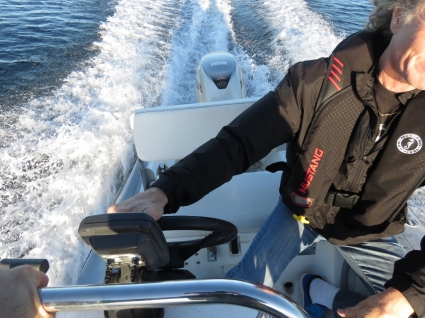
|
As we arrived back at Dirona, the tender settled into the water far deeper than it had so far. Jennifer hooked up the lifting harness and I ran up to the boat deck to lower the crane. As soon as we got the tender on the crane, we had it fully under control so the time pressure was off. But the tender must have weighed in at something close to 1,200 lbs, nearing double its normal weight.
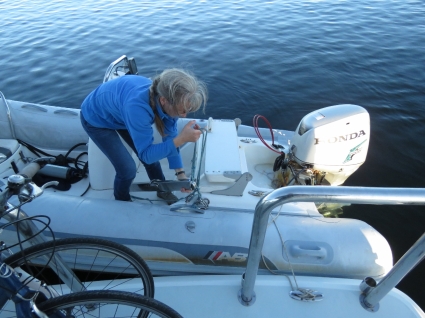
|
Ironically, the Longhope RNLI lifeboat Helen Comrie was operating nearby with a film crew on board. We were glad not to need their assistance and end up becoming part of the documentary.
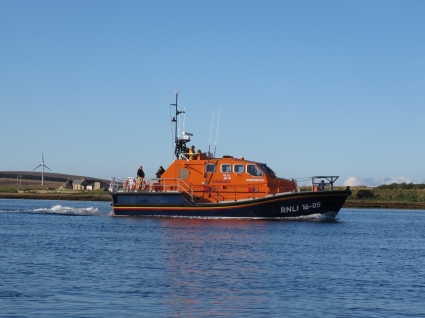
|
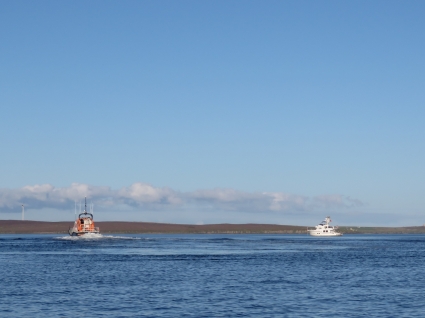
|
As the crane slowly lifted the tender, water poured out of the damaged tube and we could see what had happened.
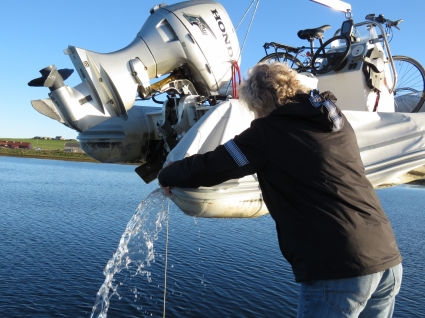
|
Rather than starting to leak slowly, a 6-8-inch seam had failed at the same time over its entire length. Because the failed seam was so large, the air was gone nearly instantly. And, since the seam was at the back of the boat, the speed of the boat formed a vacuum and sucked that tube down flat against the hull. Once we stopped, the flotation chamber quickly filled with water. We drained the tens of gallons out of the tube as it hung from the crane and, once the tender had gotten light enough to safely lift without overloading our crane, we brought it up onto the boat deck.
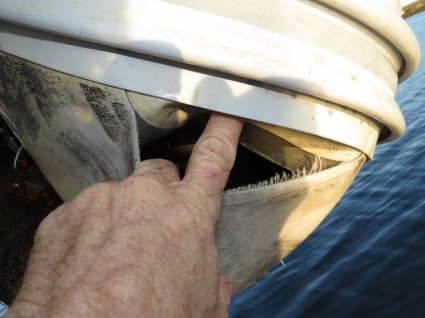
|
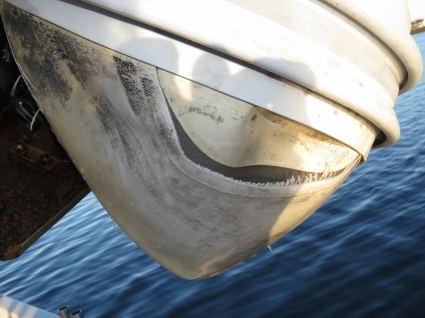
|
We used a wet/dry vacuum to get the last of the water out of the tube and started the drying process in preparation for repairing the seam the next day. Technically we do have a backup “micro-tender” that we use when we need to land in surf where the 800lb tender isn’t safe or when we have a crane or primary tender failure. We were far from stranded, but the micro-tender is just over 7ft long and powered by a 2.3hp engine, whereas the main tender is a comfortable and dry 12ft with a 40hp outboard capable of 30 MPH. The primary tender is usually the best choice, so we wanted to get it back operational.
The most sensible answer is to replace the tender since it’s now more than 8 years old (about 6 months older than Dirona) and has 550 hours of operation. We run it in difficult conditions, with some very heavy loads, and it’s exposed to a lot of sun. There are numerous reasons why replacing the boat is probably the right answer. However, replacement isn’t a quick option in the Orkney Island group north of the Scottish mainland.
We will replace the boat as quickly as we can, but needed a few more weeks or months out of it so we got to work on the repair. After waiting a day, the heavy winds so common in Northern Scotland had dried it thoroughly so we were ready to get started. We first carefully rotary wire brushed using a Dremel the surfaces of the entire length of the failed seam. This cleaned off any old glue residue and ensured that the surface was roughed up adequately and ready for glue. Then we cleaned the surfaces with MEK (wearing gloves) to ensure the surfaces were clean. Then we applied Bostick Hypalon inflatable boat glue to both sides, let the glue partially set and become tacky, and then quickly brought the two surfaces together exactly where they needed to be. We applied pressure against a metal bowl pushed up against the hull of the boat to get the appropriate curve to seal against. We then left the boat for 24 hours for the glue to cure.
Rain began to fall soon after we started work, so we rigged a large patio umbrella to cover the work area. Ideally gluing is best done between 65 and 75 °F (18 to 24 °C) with humidity below 70% and ideally at 40%. With the temperature at 54°F (12°C) and near 100% humidity we missed both by quite a large margin, but there’s not much we could do about it.
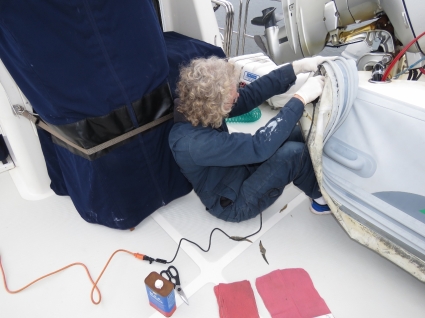
|
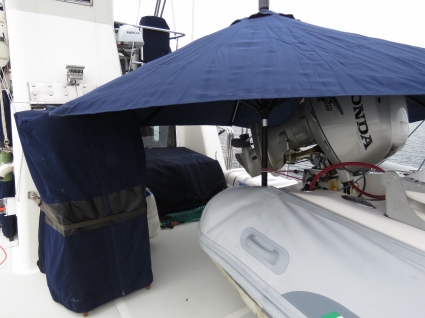
|
The next morning we pumped the tender up tightly and checked for leaks using sprayed soapy water. We found another wear point underneath, near the failed seam, where the boat was leaking fairly heavily. It may have happened due to the flapping of the deflated tube after the failure Everything else all the way around the boat looked good and was well-sealed.
We deflated the boat and cut a patch to more than cover the additional leak we found. Then we prepared both the boat and the patched surfaces again using the rotary wire wheel and MEK. Finally, we applied the glue and once it was tacky and partly set, we pushed the patch onto the location we were patching.
The large seam we had fixed the previous day was well sealed up and looked good but, since a large seam failure can be dangerous, we wanted to add an additional large patch over the entire area. We cut it to fit, used the same preparation and gluing technique, and applied the patch.
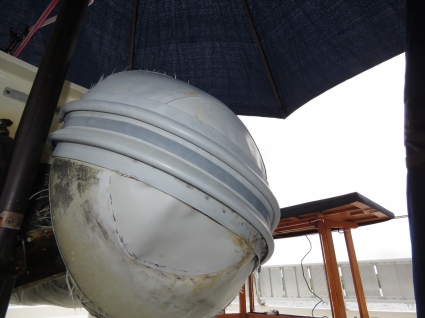
|
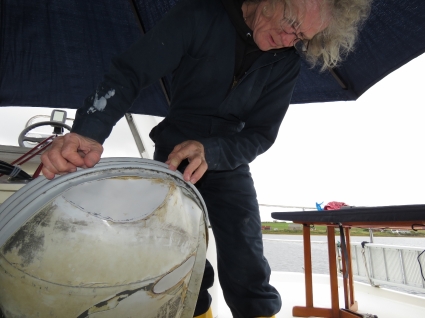
|
We gave the tender another 24 hours to cure and then again pumped it up over-full and checked for leaks. It was rock solid. We then launched the tender and put it back into work. Twelve days have passed now and the tender hasn’t leaked the tiniest amount. It’s looking great.
However, we still want to replace the tender so we’ve been shopping for an AB Alumina 12ALX with a Yamaha 30 BETL, and it’s looking like the AB shipment won’t arrive until right around the time we leave the UK. We’ll keep shopping, and will investigate shipping a boat from the US, but it’s looking like we will need to make the current boat last a bit longer at this point.
Update 2018-05-18: We eventually did buy a new tender, but it wasn’t an an AB Alumina 12ALX with a Yamaha 30. Read more at New Tender for Dirona
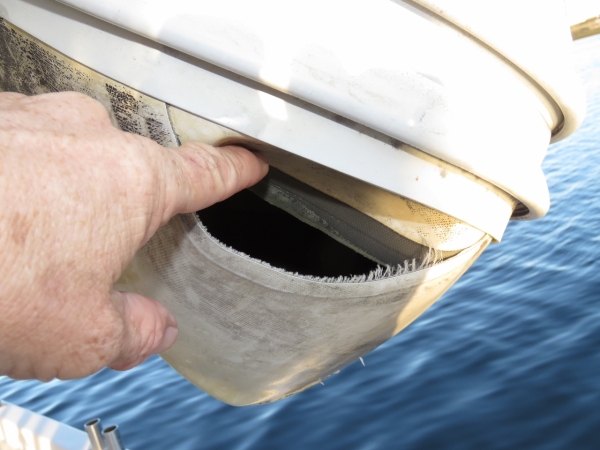
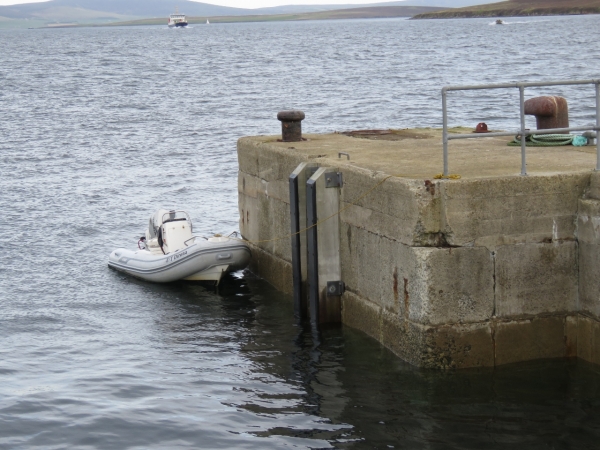
James, we’ve been looking at new tenders for our N47, ROAM. I like the AB and was very interested in the Aluminum version, but have heard horror stories about the lamination of the tubes to the Aluminum. I spoke with a guy at anchor here in Annapolis yesterday that had one and loved its performance, but was dumping it for a high line after 2 years of fighting with AB and fighting to keep the boat together. I have a Caribe now that has performed well, but the tubes are starting to delaminates. I would actually probably get a new Caribe, but the company seems to be in trouble?
I thought I’d go to AB, but they’re outrageously expensive in the US right now, for some reason. So, I’m thinking about a Brigg. I had one on my last boat and it was outstanding. They make a really nice 12 footer.
I wanted Aluminum because it’s more durable and, since it’s lighter, it’ll take less power to achieve the same speed. However, the AB Alumina 12 ALX has a maximum rated HP of 30 while our current AB 12VST has a max rated HP of 40. The 12VST is heavier but 25% more power is substantial. Doing the math with 2 people and cargo has the aluminum 12ALX at 26.6 lbs/hp whereas the fiberglass 12VST is 22.6 lbs/hp. Our current fiberglass boat will be much faster. We’re not crazy about giving up the speed of our current boat. Another interesting change, AB has reclassified the 12VST to now be able to support 50hp which under the same assumptions would yield 18 lbs/hp. That’s the direction we are heading.
We love our Highfield. it’s only about three years old but so far it’s held together really well. Zero problems.
Eliminating a second fuel (gasoline) and reducing draft and possible prop damage vs the cost (literally), performance, and 150lb weight difference, this is an interesting, even if brief, consideration – the Ribjet 10: https://www.ribjetusa.com/compactdieseljet10
Also says they may be available in UK via Superyacht Tender & Toys in UK but not sure where in UK
Superyacht Tenders and Toys
Harkstead Hall Barns
Harkstead, Ipswich, Suffolk
IP9 1DB, UK
http://superyachttendersandtoys.com/
I love the boat but it’s 3x what I want to spend starting at 59,900 for the 12′ boat and it’s 970 lbs. I think I can get the same speed, 150 lbs less on the boat deck, and something way below $20k rather than $60k. For a comparable price, I would love to have it the price performance of commodity gas solutions makes them a pretty good choice on a smaller boats like Dirona.
On a super yacht, I would do go a diesel but it’s a solution that doesn’t scale down well.
A long time reader, but first time comment!
If you did want to replace the tubes, RIB’s are incredibly popular here in the UK, and there’s no end of companies that will completely retube it for you, to be like new, for very reasonable cost. Henshaws and Paul Tilley/TIDEL are probably the best known, but both in the southern part of the country, along with many other smaller companies offering the same service (I can provide names/contacts should you want). SIT and NWRI (North West Ribs and Inflatables) are further north, and have good reputations. In the UK, I’d expect a retube of a boat that size to cost ~£3000-4000 max.
I’ll be keeping an eye out for Dirona as you make your way further south!
It turns out the new AB 12VST is now rated for a 50hp engine. The 50hp Honda weighs exactly the same as the current 40 hp engine (same engine, different tuning). So an upgrade is looking like a pretty nice solution for us.
If you or any one else reading is interested in re-tubing the boat, I can make you a very good deal on the tender that we continue to roar around in until we get the new boat but that’s the direction we’re heading at this point.
Thanks for pointing out the options Paul and, as we head south, if you are anywhere near, you should drop by and say hi.
Excellent – the upgrade option does indeed sound great! As you point out elsewhere, the current tender has had a very good innings, and given the criticality of a reliable and safe tender, a complete swap is no doubt the sensible thing to do at this point in it’s life.
I already have too many RIB’s to be allowed another, but if you want to move it on whilst in the UK, worth putting it (for free) on Rib.net, which is probably the most popular RIB forum in the UK, typically with plenty of people looking for winter project boats.
I’ll look out for you in London or along the South Coast, if you’re heading this way later this year or early next year. I’m based in London during the week for work, and my boats are in Poole on the south coast, so just shout if there’s anything I can do to help in either location.
The AB distributor doesn’t have a AB 12VST available right now. If can get a commitment to get the boat in before we leave the UK in mid-March, we’ll get it here. Otherwise, I have a boat lined up for delivery while we are in Amsterdam. I would prefer to buy it here but either way we are fine since the current tender is still running fine. We just want to make sure we have the new boat before we get to Norway.
Thanks for the pointer to Rib.net — if we buy our next boat in the UK, we’ll use rib.net.
We’ll be in Southampton for 3 weeks starting the second week of January and we’ll spend a month in London at St. Katherine Dock starting mid February. Hope to see you along the way.
I would think upgrading the tubes would be far less expensive than replacing the whole boat, engine, accessories. Not to mention less of an environmental impact.
Walt, if you are like most people, you don’t drive the same care until it has absolutely no value beyond scrap. Most decide sometime during the life of a car to upgrade to a newer vehicle. Fortunately, there is a used market and these old vehicles continue to get used. So too with boats.
In this case, our usage model needs a safer stronger boat than many missions. We’re often miles away from Dirona and have taken the tender as far as 40 miles away on day trips. We need a safe boat, I’m interested in faster boat, we’re happy about the more than 8 years and 550 hours of use we got from this boat so we’re comfortable upgrading.
You asked why not change the tubes. It’s a very practical job on commercial boats with mechanically attached tubes. On boats with glued on tubes, it can be done but the costs mount quickly. It’s more practical to continue to repair the current tubeset and I suspect someone will decided to do that.
Have you considered an Australian ”Highfield” tender http://www.highfieldboatsuk.com/
There is a dealer in Edinburgh, at Queensferry Marina
I have a CL360 in New Zealand with a 30hp Honda, you possibly want something bigger, but the quality is sublime and they may well have stock of what you need within the UK or Europe for that matter.
We’re leaning towards AB partly due to having been out in that boat in some very difficult conditions and it did amazingly well in big waves. Another factor is we have existing deck chocks, tender cover, crane harness, etc. The more different the next boat, the more work we need to face. The AB Alumina 12ALX has the same dimesions as a current boat and it’s lighter which is very attractive and the max engine is a 30hp so it’ll be both lighter and more fuel efficient. Theoretically, the aluminum boat could even be faster but sadly, that’s not the case. Assuming a loaded boat with two people, the AB Alumina 12ALX is 26.6 lbs/hp whereas our current boat, the AB Oceanus 12VST is 22.6 lbs/hp. So the current boat is faster.
Another unusual anomaly is the 12VST used to be rated for 40hp but now is rated for 50 HP. Even more interesting, a Honda 50 is exactly the same weight and size as our Honda 50 (same engine, different tuning). Using that engine, the 12VST is 18.0 lbs/HP. That’s our current leaning bu thanks for the pointer to the Highfield tender.
Have you considered the aluminum “Ocean Craft” tenders? Its what they use on SV Delos
https://svdelos.com/travel-blogs/meet-maggie-brady/
I’ll check out Ocean Craft. Thanks Michael.
Does your current Honda 40 have the NMEA coupler and, if so, do you use it? Is your Garmin connected to it? Will your new Yamaha engine choice be similar?
Our AB 12VST has a standard analog gauge pack including voltmeter, tachometer, speedometer, and fuel level. I don’t know of a NMEA0183 port on the Honda. The Garmin depth sounder is a stand alone unit that is not otherwise networked.
We have run into two problems with the proposed new boat. The first is that there are no new AB 12ALX boats currently available in the UK and the expected arrival time for the next shipment is dangerously close to when we leave the country. Probably too close. The next problem is I’m getting concerned on power. Looking at our current boat with a load of two passengers and some light cargo, it is 22.6 lbs/hp. The proposed new boat is lighter but it’s max engine HP is 30 rather than 40 and in using the same load, the new boat would be a far worse 26.6 lb/hp. I don’t want a lower performing boat so I’m back to the drawing board on this one. The fiberglass Oceanus 12VST is heavier but it also carries more power and the overall package is a better performing boat. Unfortunately, there aren’t any AB 12VSTs in the UK either so we’re not sure what direction we’re going to go at this point.